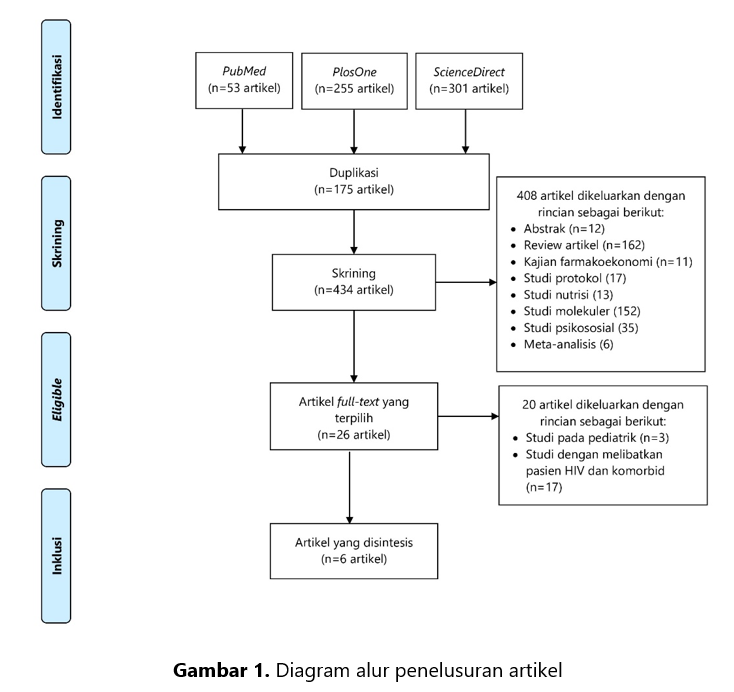Effectiveness and Side Effects in the Management of Multi-Drug-Resistant Tuberculosis (MDR-TB): A Narrative Review
DOI:
https://doi.org/10.36733/medicamento.v11i1.9685Keywords:
amikacin, bedaquiline, fluoroquinolone, MDR-TBAbstract
Multi-drug-resistant tuberculosis (MDR-TB) leads to a reduced cure rate for tuberculosis treatment. The global number of MDR-TB cases remained relatively stable between 2015 and 2020 but increased in 2021. In 2020, the World Health Organization (WHO) estimated 437,000 MDR-TB cases worldwide, which rose to 450,000 cases in 2021. Various treatment regimens recommended by the WHO require a review of the literature on the efficacy and side effects of drug use in MDR-TB. This review aims to provide updated information that can be used as a reference for the early identification and management of side effects. The article was a narrative review that collected and analyzed information from various international articles on databases such as PubMed, PlosOne, and ScienceDirect from January 2014 to June 2024. A total of six relevant articles were synthesized from 609 articles. The effectiveness of MDR-TB therapy with WHO-recommended drugs has shown a high cure rate (cured>50%). The incidence of side effects in MDR-TB therapy is smaller compared to the effectiveness of treatment. However, a study conducted at Wuhan Jinyintan Hospital in China from July 2019 to December 2020 showed that all study subjects experienced side effects. This included nausea and vomiting from protionamide, gatifloxacin, and ethambutol; hyperuricemia from pyrazinamide, and hyperpigmentation from clofazimine. It is recommended that a therapy regimen be selected based on culture test results, patient conditions, and drug availability in each country.
References
World Health Organization. Global tuberculosis report 2019 (World Health Organization, 2019). Published online 2019.
World Health Organization. Global Tuberculosis Report 2022.; 2022.
Kemenkes. Laporan Program Penanggulangan Tuberkulosis Tahun 2021. Kementerian Kesehatan RI; 2021.
World Health Organization. WHO Consolidated Guidelines on Tuberculosis.; 2022.
Agyeman AA, Ofori-Asenso R. Tuberculosis—an overview. Public Heal Emerg. 2016;1(November):37-37. doi:10.21037/phe.2016.10.04
Bansal R, Sharma D, Singh R. Tuberculosis and its Treatment: An Overview. Mini-Reviews Med Chem. 2016;18(1):58-71. doi:10.2174/1389557516666160823160010
World Health Organization. Global tuberculosis report 2015. Published online 2015.
The Working Group for New TB Drugs. No Title. Clinical Pipeline. 2016. Accessed July 31, 2024. https://www.newtbdrugs.org/pipeline/clinical?field_advancing_value=1&field_submitted_for_registration_value%5B%5D=1
The U.S. Food and Drug Administration. No Title. FDA approves new drug for treatment-resistant forms of tuberculosis that affects the lungs. 2019. Accessed July 30, 2024. https://www.fda.gov/news-events/press-announcements/fda-approves-new-drug-treatment-resistant-forms-tuberculosis-affects-lungs
The U.S. Food and Drug Administration. No Title. Drug Approval Package. 2020. Accessed July 31, 2024. https://www.accessdata.fda.gov/drugsatfda_docs/nda/2000/21024S5_Priftin.cfm
Rahman N, Meng SK, Ahmed IA. Current Review of the Use of Linezolid in the Treatment of Multidrug-Resistant Tuberculosis: Effectiveness and Management of Side Effects. Int J Biotechnol Biomed. 2024;1(1):89-102. doi:https://doi.org/10.31674/ijbb.2024.v01i01.005
Ari Kusuma Yana IGA, Herawati F. Efektivitas Dan Keamanan Terapi dengan Rejimen Bedaquiline dalam Terapi Multidrug-Resistant Tuberculosis (TB-MDR): Kajian Sistematis. Pharm J Indones. 2022;7(2):129-138. doi:10.21776/ub.pji.2022.007.02.8
Thariqulhaq MF, Wahyono TYM. The Effectiveness And Safety Of Bedaquiline-Containing Regimens In The Treatment Of Patients With Multi-Drug Resistant Tuberculosis (Mdr-Tb): A Systematic Literature Review. J EduHealth. 2023;14(03):1382-1392. doi:https://doi.org/10.54209/jurnaleduhealth.v14i3.2678
Sari E, Zakiah N, Santoso P, Barliana MI. EFektivitas Terapi Bedaquilin Dan Delamanid Pada Pengobatan Multidrug-Resistant Tuberculosis (MDR-TB): Sebuah Review. J Sains dan Teknol Farm Indones. 2020;9(1).
Mahardani PN, Wati DK, Siloam A, Savitri NPA, Manggala AK. Effectiveness and safety of short-term regimen for multidrug-resistant tuberculosis treatment: a systematic review of cohort studies. Oman Med J. 2022;37(1):e337. doi:https://doi.org/10.5001/omj.2021.64
Wu S, Zhang Y, Sun F, et al. Adverse events associated with the treatment of multidrug-resistant tuberculosis: A systematic review and meta-analysis. Am J Ther. 2016;23(2):e521-e530. doi:10.1097/01.mjt.0000433951.09030.5a
Zeng X, Zhang Y, Kwong JSW, et al. The methodological quality assessment tools for preclinical and clinical studies, systematic review and meta‐analysis, and clinical practice guideline: a systematic review. J Evid Based Med. 2015;8(1):2-10. doi:https://doi.org/10.1111/jebm.12141
Sun W, Wu Z, Zhou Y, et al. A highly effective and inexpensive standardized treatment of multidrug-resistant tuberculosis: a multicenter prospective study in China. BMC Infect Dis. 2021;21:1-9. doi:https://doi.org/10.1186/s12879-021-06553-2
Yao G, Zhu M, Nie Q, et al. Improved outcomes following addition of bedaquiline and clofazimine to a treatment regimen for multidrug-resistant tuberculosis. J Int Med Res. 2023;51(1):03000605221148416. doi:10.1177/03000605221148416
D’Ambrosio L, Bothamley G, Luna JAC, et al. Team approach to manage difficult-to-treat TB cases: experiences in Europe and beyond. Pulmonology. 2018;24(2):132-141. doi:https://doi.org/10.1016/j.rppnen.2017.10.005
Tiberi S, Buchanan R, Caminero JA, et al. The challenge of the new tuberculosis drugs. Presse Med. 2017;46(2):e41-e51. doi:http://dx.doi.org/10.1016/j.lpm.2017.01.016
Sun F, Li Y, Chen Y, et al. Introducing molecular testing of pyrazinamide susceptibility improves multidrug-resistant tuberculosis treatment outcomes: a prospective cohort study. Eur Respir J. 2019;53(3). doi:10.1183/13993003.01770-2018
Sangsayunh P, Sanchat T, Chuchottaworn C, Cheewakul K, Rattanawai S. The use of BPaL containing regimen in the MDR/PreXDR TB treatments in Thailand. J Clin Tuberc Other Mycobact Dis. 2024;34:100408. doi:10.1016/j.jctube.2023.100408
Nie Q, Tao L, Li Y, et al. High-dose gatifloxacin-based shorter treatment regimens for MDR/RR-TB. Int J Infect Dis. 2022;115:142-148. doi:10.1016/j.ijid.2021.11.037
Munir MK, Saeed MS, Haider SZ, Shamim S. Comparison of short term and long term multidrug resistant tuberculosis treatment outcomes in tertiary care settings. J King Saud Univ. 2024;36(4):103133. doi:10.1183/13993003.01770-2018
Bhanu MLS. Anti-Tuberculosis Drugs and Mechanisms of Action: Review. IJ Infect Disea. 2023;4(2):1-7.
Kwon YS, Jeong BH, Koh WJ. Tuberculosis: clinical trials and new drug regimens. Curr Opin Pulm Med. 2014;20(3):280-286. doi:10.1097/MCP.0000000000000045
Hooper DC, Jacoby GA. Topoisomerase inhibitors: fluoroquinolone mechanisms of action and resistance. Cold Spring Harb Perspect Med. 2016;6(9):a025320. doi:10.1101/cshperspect.a025320
Chauhan A, Kumar M, Kumar A, Kanchan K. Comprehensive review on mechanism of action, resistance and evolution of antimycobacterial drugs. Life Sci. 2021;274:119301. doi:10.1016/j.lfs.2021.119301
Jones NT, Abadie R, Keller CL, et al. Treatment and toxicity considerations in tuberculosis: A narrative review. Cureus. 2024;16(6). doi:10.7759/cureus.62698
Nugraha RV, Yunivita V, Santoso P, Aarnoutse RE, Ruslami R. Clofazimine as a treatment for multidrug-resistant tuberculosis: a review. Sci Pharm. 2021;89(2):19. doi:https://doi.org/10.3390/scipharm89020019
Hong H, Dowdy DW, Dooley KE, et al. Risk of hearing loss among multidrug-resistant tuberculosis patients according to cumulative aminoglycoside dose. Int J Tuberc Lung Dis. 2020;24(1):65-72. doi:https://doi.org/10.5588/ijtld.19.0062

Downloads
Submitted
Accepted
Published
How to Cite
Issue
Section
License
Copyright (c) 2025 Dwi Arymbhi Sanjaya, Herleeyana Meriyani, Rr. Asih Juanita, Nyoman Budiartha Siada, Lusy Noviani

This work is licensed under a Creative Commons Attribution-NonCommercial-NoDerivatives 4.0 International License.

















